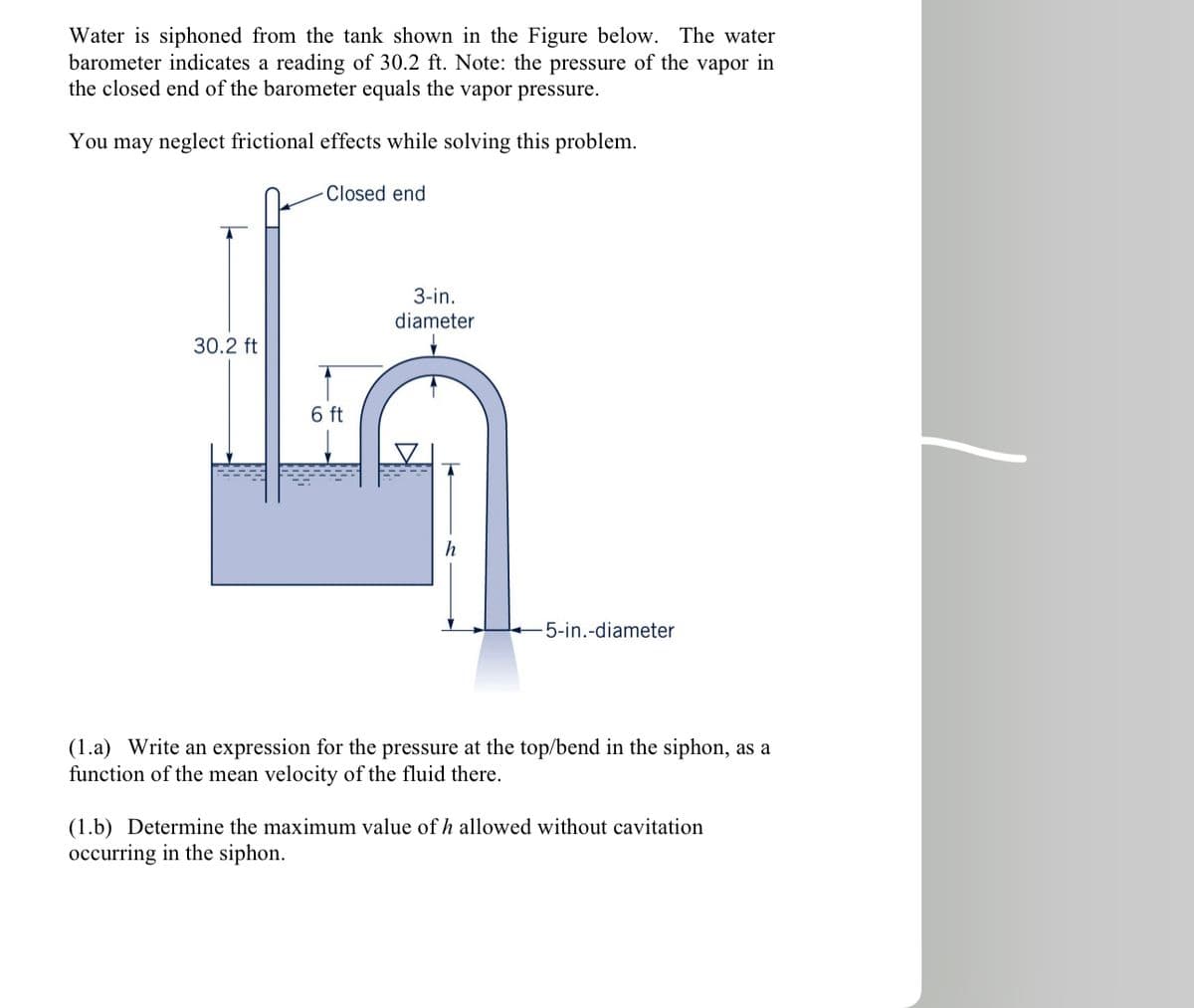Water is siphoned from the tank shown in the Figure below. The water barometer indicates a reading of 30.2 ft. Note: the pressure of the vapor in the closed end of the barometer equals the vapor pressure. You may neglect frictional effects while solving this problem. Closed end 3-in. diameter 30.2 ft 6 ft 5-in.-diameter (1.a) Write an expression for the pressure at the top/bend in the siphon, as a function of the mean velocity of the fluid there. (1.b) Determine the maximum value of h allowed without cavitation occurring in the siphon.
Water is siphoned from the tank shown in the Figure below. The water barometer indicates a reading of 30.2 ft. Note: the pressure of the vapor in the closed end of the barometer equals the vapor pressure. You may neglect frictional effects while solving this problem. Closed end 3-in. diameter 30.2 ft 6 ft 5-in.-diameter (1.a) Write an expression for the pressure at the top/bend in the siphon, as a function of the mean velocity of the fluid there. (1.b) Determine the maximum value of h allowed without cavitation occurring in the siphon.
Introduction to Chemical Engineering Thermodynamics
8th Edition
ISBN:9781259696527
Author:J.M. Smith Termodinamica en ingenieria quimica, Hendrick C Van Ness, Michael Abbott, Mark Swihart
Publisher:J.M. Smith Termodinamica en ingenieria quimica, Hendrick C Van Ness, Michael Abbott, Mark Swihart
Chapter1: Introduction
Section: Chapter Questions
Problem 1.1P
Related questions
Question

Transcribed Image Text:Water is siphoned from the tank shown in the Figure below. The water
barometer indicates a reading of 30.2 ft. Note: the pressure of the vapor in
the closed end of the barometer equals the vapor pressure.
You may neglect frictional effects while solving this problem.
-Closed end
3-in.
diameter
30.2 ft
6 ft
-5-in.-diameter
(1.a) Write an expression for the pressure at the top/bend in the siphon, as a
function of the mean velocity of the fluid there.
(1.b) Determine the maximum value of h allowed without cavitation
occurring in the siphon.
Expert Solution
This question has been solved!
Explore an expertly crafted, step-by-step solution for a thorough understanding of key concepts.
This is a popular solution!
Trending now
This is a popular solution!
Step by step
Solved in 6 steps with 1 images

Knowledge Booster
Learn more about
Need a deep-dive on the concept behind this application? Look no further. Learn more about this topic, chemical-engineering and related others by exploring similar questions and additional content below.Recommended textbooks for you

Introduction to Chemical Engineering Thermodynami…
Chemical Engineering
ISBN:
9781259696527
Author:
J.M. Smith Termodinamica en ingenieria quimica, Hendrick C Van Ness, Michael Abbott, Mark Swihart
Publisher:
McGraw-Hill Education

Elementary Principles of Chemical Processes, Bind…
Chemical Engineering
ISBN:
9781118431221
Author:
Richard M. Felder, Ronald W. Rousseau, Lisa G. Bullard
Publisher:
WILEY

Elements of Chemical Reaction Engineering (5th Ed…
Chemical Engineering
ISBN:
9780133887518
Author:
H. Scott Fogler
Publisher:
Prentice Hall

Introduction to Chemical Engineering Thermodynami…
Chemical Engineering
ISBN:
9781259696527
Author:
J.M. Smith Termodinamica en ingenieria quimica, Hendrick C Van Ness, Michael Abbott, Mark Swihart
Publisher:
McGraw-Hill Education

Elementary Principles of Chemical Processes, Bind…
Chemical Engineering
ISBN:
9781118431221
Author:
Richard M. Felder, Ronald W. Rousseau, Lisa G. Bullard
Publisher:
WILEY

Elements of Chemical Reaction Engineering (5th Ed…
Chemical Engineering
ISBN:
9780133887518
Author:
H. Scott Fogler
Publisher:
Prentice Hall


Industrial Plastics: Theory and Applications
Chemical Engineering
ISBN:
9781285061238
Author:
Lokensgard, Erik
Publisher:
Delmar Cengage Learning

Unit Operations of Chemical Engineering
Chemical Engineering
ISBN:
9780072848236
Author:
Warren McCabe, Julian C. Smith, Peter Harriott
Publisher:
McGraw-Hill Companies, The